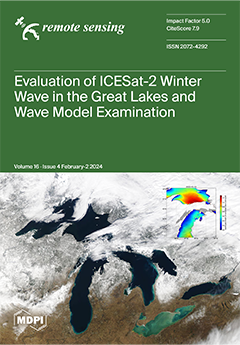Accurate monitoring of crop drought thresholds at different growth periods is crucial for drought monitoring. In this study, the canopy temperature (T
c) of winter wheat (‘Weilong 169’ variety) during the three main growth periods was extracted from high-resolution thermal and multispectral
[...] Read more.
Accurate monitoring of crop drought thresholds at different growth periods is crucial for drought monitoring. In this study, the canopy temperature (T
c) of winter wheat (‘Weilong 169’ variety) during the three main growth periods was extracted from high-resolution thermal and multispectral images taken by a complete unmanned aerial vehicle (UAV) system. Canopy-air temperature difference (ΔT) and statistic Crop Water Stress Index (CWSI
si) indicators were constructed based on T
c. Combined experiment data from the field and drought thresholds for the ΔT and CWSI
si indicators for different drought levels at three main growth periods were monitored. The results showed a strong correlation between the T
c extracted using the NDVI-OTSU method and ground-truth temperature, with an R
2 value of 0.94. The CWSI
si was more stable than the ΔT index in monitoring the drought level affecting winter wheat. The threshold ranges of the CWSI
si for different drought levels of winter wheat at three main growth periods were as follows: the jointing–heading period, where the threshold ranges for normal, mild drought, moderate drought, and severe drought are <0.30, 0.30–0.42, 0.42–0.48, and >0.48, respectively; the heading–filling period, where the threshold ranges for normal, and mild, moderate, and severe drought are <0.33, 0.33–0.47, 0.44–0.53, and >0.53, respectively; and the filling–maturation period, where the threshold ranges for normal, mild drought, moderate drought, and severe drought are <0.41, 0.41–0.54, 0.54–0.59, and >0.59, respectively. The UAV thermal threshold method system can improve the accuracy of crop drought monitoring and has considerable potential in crop drought disaster identification.
Full article





